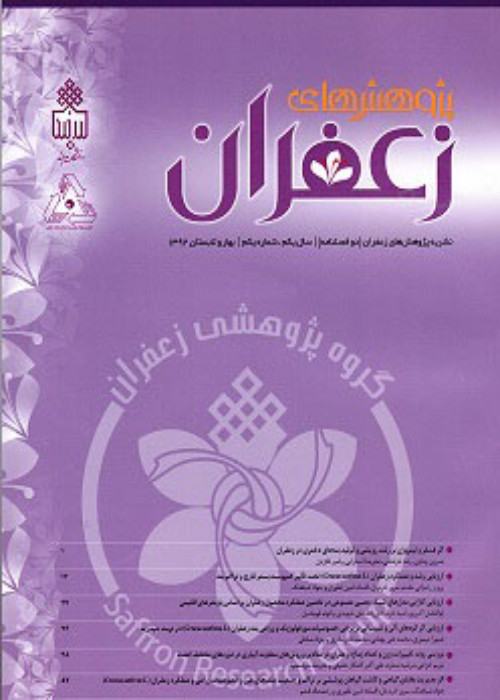Effects of Mycorrhiza Inoculation, Mother Corm Weight and Humic Acid on Daughter Corm and Flower Yield of saffron
Author(s):
Article Type:
Research/Original Article (بدون رتبه معتبر)
Abstract:
Introduction
Saffron (Crocus sativus L.) is a plant that propagates vegetatively by means of a corm formation. During each growing season, saffron propagates by daughter corms produced from the mother corm. The daughter corms are formed above the mother corm. The mature and bigger corms in the previous studies have shown more flowers and daughter corms. In sustainable agriculture the uptake of different nutrients such as N, P, S, Ca, Cu, Zn, Fe and crop yield is strongly influenced by organic fertilizers, microbial symbionts, such as mycorrhizal fungi, and nitrogen fixing rhizobacteria. Mycorrhiza is particularly important due to its ability to improve the uptake of inorganic P, by the activity of secreted phosphatases and organic compounds. Another advantage conferred by AMF is enhancing plant resistance to several biotic and abiotic stresses including drought, salinity, nutrient deficiency, and toxic metal deposition. Also, the application of organic fertilizer can improve soil fertility, reduce soil-borne diseases, and enhance microbial flora structure. Humic acid is a kind of organic matter produced and accumulated by animal and crop remains through decomposition and transformation of microorganisms with a series of geochemistry processes. This study aimed to investigate the impacts of mycorrhiza inoculation, mother corm weight and humic acid on the daughter corm and flower yield of saffron. Materials and Methods
This field experiment was conducted as factorial layout based on a randomized complete block design with three replications at the Agricultural Research Station, Ferdowsi University of Mashhad during the years 2019-2020. Treatments were three mother corm sizes ((such as <4 g (as small corms), 4.1-8 g (as medium corms) and 8.1-12 g (as large corms)), inoculation with three species of mycorrhizal fungi (Glomus etunicatum, G. mosseae and G. intraradices and triple combinations of these species fungi and control (without inoculation)), and two rates of humic acid (with and without humic acid (as control)). Studied traits were flower numbers per unit area, fresh weight of flower, dried weight of flower, fresh weight of stigma, dried weight of stigma, fresh weight of stamen, dried weight of stamen, number of daughter corms and dried weight of daughter corms. Results and Discussion
The results showed that the highest rate of large mother corms (8.1-12 g) was observed in large corms + G. intraradices+humic acid with 109 g.m-2. Also, the maximum weight of medium daughter corms (4.1-8 g) was achieved in large mother corms + G. intraradices+ humic acid with 63 g.m-2. The highest numbers of daughter corms were related to triple combinations of mycorrhizal fungi+ large mother corms+ humic acid with 67 corms per m-2. The highest flower numbers (67 flowers per m-2), dried weight of stamen (2.79 g.m-2), dried weight of stamen (0.28 g.m-2), were recorded for triple combinations of mycorrhizal fungi+ large mother corms+ humic acid. Conclusion
The results showed that the improvement of saffron management (such as selecting bigger and higher quality corm, fertilization, appropriate density, etc.) is the best way to increase the saffron yield. Humic acid recognized as a possible tool in facing environmental problems especially conventional management. Many of their positive effects on soil and plant growth have been demonstrated to rely on their chemical composition. Also, the effect of mycorrhiza symbiosis on a particular plant species meaning that not all AMF fungi nor strains of the same species will have an identical impact on a particular plant species. Therefore, mycorrhiza is of great importance to assure the presence of beneficial symbionts that are adapted to a given soil and climate or if inoculation is planned, to select the most effective partners. Generally, the results revealed that the large mother corms had high correlation with daughter corm yield, flower yield and stigma yield of saffron. Also, humic acid application and inoculation with mycorrhiza species were improved flower yield and daughter corm yield of saffron.Keywords:
Language:
Persian
Published:
Journal of Saffron Research, Volume:11 Issue: 1, 2023
Pages:
48 to 65
https://magiran.com/p2617337
دانلود و مطالعه متن این مقاله با یکی از روشهای زیر امکان پذیر است:
اشتراک شخصی
با عضویت و پرداخت آنلاین حق اشتراک یکساله به مبلغ 1,390,000ريال میتوانید 70 عنوان مطلب دانلود کنید!
اشتراک سازمانی
به کتابخانه دانشگاه یا محل کار خود پیشنهاد کنید تا اشتراک سازمانی این پایگاه را برای دسترسی نامحدود همه کاربران به متن مطالب تهیه نمایند!
توجه!
- حق عضویت دریافتی صرف حمایت از نشریات عضو و نگهداری، تکمیل و توسعه مگیران میشود.
- پرداخت حق اشتراک و دانلود مقالات اجازه بازنشر آن در سایر رسانههای چاپی و دیجیتال را به کاربر نمیدهد.
In order to view content subscription is required
Personal subscription
Subscribe magiran.com for 70 € euros via PayPal and download 70 articles during a year.
Organization subscription
Please contact us to subscribe your university or library for unlimited access!



